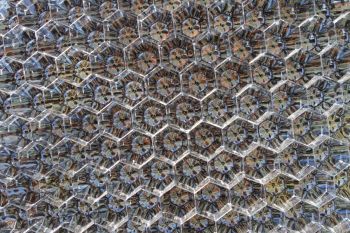MAGIC
Skip navigation and go to main content
- Home
- General Information
- Science with MAGIC
- MAGIC members
- Maintenance

Technical implementations » Camera
The cameras of both MAGIC telescopes consist of 1039 photomultiplier tubes (PMTs), arranged in a circle of about 1 meter diameter, which gives each camera a field of view in the sky of 3.5 degrees.
The PMTs from Japanese manufacturer Hamamatsu have a diameter of 25.4mm. They consist of a hemispherical photocathode and 6 dynodes, with a hexagonal Winston cone mounted on top to increase the amount of collected light and to avoid gaps between the circular pixels. The PMTs are operated at a rather low gain of 30-40.000 to also allow observations under moderate moonlight without damaging the dynodes. The PMT bias voltages for the cathode and dynodes are generated by a low power, nine step Cockroft-Walton DC-DC converter, which can provide up to 1250V peak voltage. Differences in gain for different PMTs are compensated by adjusting their high voltage setting independently with the so-called flatfielding procedure.
The electrical signals are amplified and then transmitted through optical fibers by means of vertical cavity surface emitting lasers (VCSELs). The fibers continuously transmit analog signals from the PMTs to the readout and trigger electronics located in the counting house. They are about 162 meters long and protected by a UV resistant PVC covers.
The calibration of the cameras is performed through uniform illumination of the PMTs with well-characterized light pulses of different intensity. The light is produced by a calibration box installed at the center of the mirror dish, about 17 meters away from the camera plane. The calibration box is based on a system with a passively Q-switched Nd:YAG laser (third harmonics, wavelength of 355 nm) that produces pulses of 0.4 ns width. The light intensity is adjusted through the selection of a calibrated optical filter and the uniformity is achieved by means of an Ulbricht sphere that diffuses the light right before the exit window.

